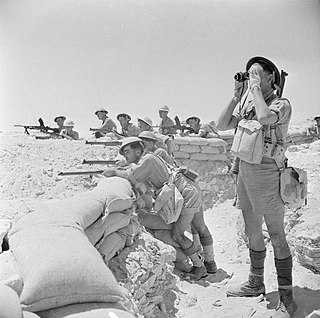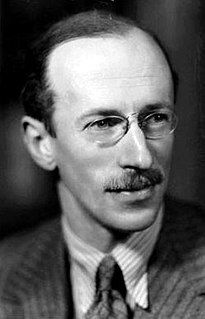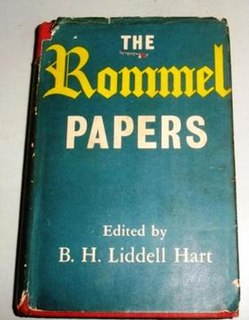
Johannes Erwin Eugen Rommel was a German general and military theorist. Popularly known as the Desert Fox, he served as field marshal in the Wehrmacht of Nazi Germany during World War II, as well as serving in the Reichswehr of the Weimar Republic, and the army of Imperial Germany.

The First Battle of El Alamein was a battle of the Western Desert Campaign of the Second World War, fought in Egypt between Axis forces of the Panzer Army Africa and Allied forces of the Eighth Army.

The Battle of Anzio was a battle of the Italian Campaign of World War II that took place from January 22, 1944 to June 5, 1944. The operation was opposed by German forces in the area of Anzio and Nettuno.
The Battle of Cisterna took place during World War II, on 30 January–2 February 1944, near Cisterna, Italy, as part of the Battle of Anzio, part of the Italian Campaign. The battle was a clear German victory which also had repercussions on the employment of U.S. Army Rangers that went beyond the immediate tactical and strategic results of the battle.

During World War II, Operation Gaff was the parachuting of a six-man patrol of Special Air Service commandos into German-occupied France on Tuesday 25 July 1944, with the aim of killing or kidnapping German Field Marshal Erwin Rommel.
The 2nd New Zealand Division, initially the New Zealand Division, was an infantry division of the New Zealand Military Forces during the Second World War. The division was commanded for most of its existence by Lieutenant-General Bernard C. Freyberg. It fought in Greece, Crete, the Western Desert and Italy. In the Western Desert Campaign, the division played a prominent role in the defeat of German and Italian forces in the Second Battle of El Alamein and the British Eighth Army's advance to Tunisia.

The North African campaign of the Second World War took place in North Africa from 10 June 1940 to 13 May 1943. It included campaigns fought in the Libyan and Egyptian deserts and in Morocco and Algeria, as well as Tunisia.

The VI Corps was activated as VI Army Corps in August 1918 at Neufchâteau, France, serving in the Lorraine Campaign. Constituted in the Organized Reserves in 1921, it was allotted to the Regular Army in 1933 and activated on 1 August 1940 at Fort Sheridan, Illinois. VI Corps took part in some of the most high-profile operations in World War II.

The Battle of Gazala was fought during the Western Desert Campaign of the Second World War, west of the port of Tobruk in Libya, from 26 May to 21 June 1942. Axis troops of the Panzerarmee Afrika consisting of German and Italian units fought the British Eighth Army composed mainly of British Commonwealth, Indian and Free French troops.

The Desert Fox is a 1951 black-and-white biographical war film from 20th Century Fox about Field Marshal Erwin Rommel in the later stages of World War II. It stars James Mason in the title role, was directed by Henry Hathaway, and was based on the book Rommel: The Desert Fox by Brigadier Desmond Young, who served in the British Indian Army in North Africa.
Steven J. Zaloga is an American author and defense consultant. He received a bachelor's degree cum laude at Union College and a masters degree at Columbia University, both in history.

The Desert Rats is a 1953 American black-and-white war film from 20th Century Fox, produced by Robert L. Jacks, directed by Robert Wise, that stars Richard Burton, James Mason, and Robert Newton. The film's storyline concerns the Siege of Tobruk in North Africa during World War II.

The Battle of Mersa Matruh was fought from 26 to 29 June 1942, following the defeat of the Eighth Army at the Battle of Gazala and was part of the Western Desert Campaign of the Second World War. The combatant on the Axis side was the Panzer Army Afrika (Panzerarmee Afrika, consisting of German and Italian units. The Allied forces of the Eighth Army comprised X Corps and XIII Corps. The battle developed as the Afrika Korps pursued the Eighth Army as it retreated into Egypt. Rommel intended to engage and destroy the Allied infantry formations in detail, before the British had a chance to regroup. The Axis cut off the line of retreat of X Corps and XIII Corps but was too weak to stop the British from breaking out. The fortress port of Mersa Matruh and 6,000 prisoners were captured, along with a great deal of supplies and equipment but the Eighth Army survived.

Sir Basil Henry Liddell Hart, commonly known throughout most of his career as Captain B. H. Liddell Hart, was a British soldier, military historian and military theorist. He wrote a series of military histories that proved influential among strategists. He argued that frontal assault was a strategy that was bound to fail at great cost in lives, as happened in the First World War. He instead recommended the "indirect approach" and reliance on fast-moving armoured formations.
XIV Panzer Corps was a corps-level formation of the German Army which fought on both the Eastern Front and in the Italian Campaign.

The Rommel myth, or the Rommel legend, is a phrase used by a number of historians for the common depictions of German field marshal Erwin Rommel as an apolitical, brilliant commander and a victim of Nazi Germany due to his presumed participation in the 20 July plot against Adolf Hitler, which led to his forced suicide in 1944. According to these historians, who take a critical view of Rommel, such depictions are not accurate.

Rommel: The Desert Fox is a 1950 biography of German Field Marshal Erwin Rommel by Desmond Young. The book was the first biography of Rommel and enjoyed immense popularity, especially in Britain. The book led the Western Allies, particularly the British, to depict Rommel as the "good German" and "our friend Rommel", contributing to the formation of the Rommel myth.

The Rommel Papers is the collected writings by the German World War II field marshal Erwin Rommel published in 1953.
Heinrich von Prittwitz und Gaffron was a general officer in the Heer (Army) branch of the Wehrmacht of Nazi Germany during World War II. He was commander of the 14th and 15th Panzer Divisions and was killed in action in the early stages of the Siege of Tobruk.

A significant controversy exists over Germany's Bundeswehr's use of Erwin Rommel as its role model. Numerous critics take issue with the Bundeswehr's reverence towards Rommel as its primary role model. While recognizing his great talents as a commander, they point out several problems: such as Rommel's involvement with a criminal regime and his political naivete. However, there are also many supporters of the continued commemoration of Rommel by the Bundeswehr, and there remains military buildings and streets named after him and portraits of him displayed.













